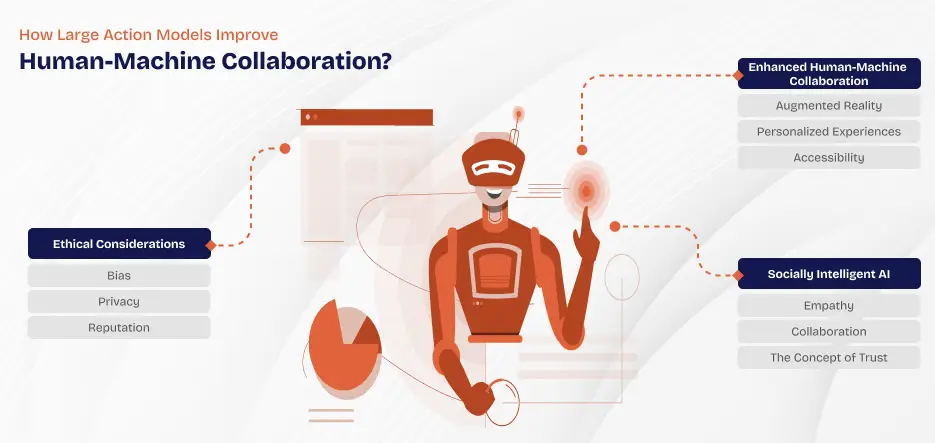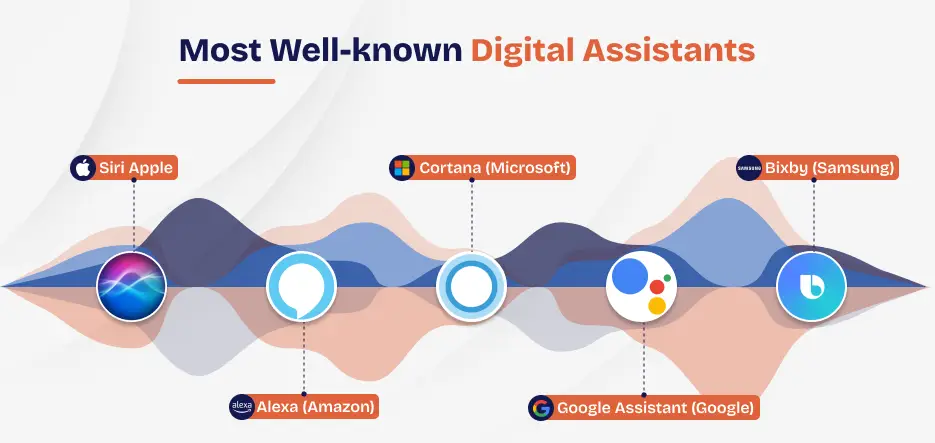Table of Contents
In Artificial Intelligence (AI), language models have dominated different industries for years. Some tasks can be simplified in the modern world, like text generation, summarization, translation, etc. AI is now evolving towards actionable abilities, where the technology goes beyond data analysis to execute daily tasks.
Integrating AI into business can unlock the potential for optimization, innovation, and automation, eventually leading to better outcomes and efficiency. The LAM large action model is a driving force behind this technology and shows the evolution of AI.
This blog will help you understand the evolution of large action model AI, key technology driving LLMs, benefits, challenges, and future. Read it till the end to get detailed information on the topic.
Statistics About Large Action Models (LAM) & Large Language Models (LLM)
Here is the market estimate of large action model LAM as well as LLM:
- The global large language model AI Market is experiencing rapid expansion, with estimates suggesting an increase of nearly 50% in size. Estimates indicate a significant growth in the market’s value, increasing from 6.4 billion as of 2024 to 36.1 billion in 2030, a substantial growth rate of 33.2% for the forecast time.
- Based on application technology, the chatbots and digital assistant segment had the largest market share of 26.4% by 2024. Based on the deployment model, the on-premise segment dominated in 2024 and had the highest revenue share at 57%.
- The market for AI-related technology is estimated to be enormous. It was estimated to be around 200 billion U.S. dollars in 2023 and is predicted to increase significantly more than this in 2030, reaching over 1.8 trillion U.S. dollars. Large action model LAM is among the most transformative technologies that will be utilized in the rapidly growing field of artificial Intelligence.

Source:- marketsandmarkets.com
Understanding the Evolution of AI Models
The path to AI began in the 1950s with the groundbreaking research by Alan Turing, who proposed the Turing Test to determine if machines could imitate human intelligence. Through the 60s, AI development gained speed by creating the initial AI programming language, LISP, developed by John McCarthy. The early AI systems centred on rules-based and symbolic reasoning, which created expert systems during the 1970s and 1980s.
The 1990s saw a shift towards machine learning and data-driven strategies due to the increasing accessibility of digital data and technological advances in computing. This time saw the rise of neural networks and the advancement of support vector machines, which enabled AI algorithms to understand data patterns, resulting in higher performance and greater adaptability. In the early 2000s, AI research expanded into new areas like the processing of natural languages, computer vision, and robotics, paving the way for the current AI revolution.
GPT: The Game Changer
The recent surge in AI is primarily due to advanced deep learning methods and the development of massive-scale neural networks like GPT-3, part of the Generative Pre-trained Transformer (GPT) series from OpenAI. GPT-3 was released at the end of 2020. It provides an outstanding illustration of how AI has advanced. It is astonished by its 175 billion parameters, showing a remarkable natural ability to understand language and generate new words.
The popularity of GPT -3 and its precursors proves AI’s potential and has led to more research and advancement in the area. The most recent version, GPT-4, builds on its predecessors and displays greater capabilities that are extending AI’s limits even further. Companies looking to leverage this technology can hire ChatGPT developers to implement customized AI solutions for various applications.
Key Technologies Driving Large Action Models (LAMs)
Large Action Models LAM in Artificial Intelligence have an advanced technical structure built to tackle complex tasks precisely. Here’s a list of the essential elements that make up these fantastic systems:
Action Representation
LAMs formalize actions using a mix of procedural and symbolic representations. They provide a flexible framework capable of handling an array of tasks with a high degree of precision.
Action Hierarchy
By embracing a hierarchical structure, large action models manage actions according to a tree-like structure, with higher-level actions coordinating lower-level counterparts. This model of hierarchies facilitates the smooth execution and planning of complicated actions.
Planning Engine
The heart of the large action model AI lies in a robust planning engine, which meticulously creates action sequences that achieve predefined goals. By analysing the state of affairs and the available actions, the planning engine develops strategies designed to be successful.
Execution Module
LAMs utilize an execution module to execute the sequences of actions they have generated. The module coordinates the execution of sub-tasks, ensuring efficient and synchronized task execution.
Learning and Adaptation
LAMs ‘ premise is continuous evolution since they leverage the ability to learn and adapt. By constantly refining the representation of actions and enhancing their ability to plan, large action models adjust their behaviour according to feedback and experiences, continually improving their capabilities.
Benefits of Large Action Models for Industry Transformation
Actionable AI provides a wide range of advantages for companies across different sectors. Here are a few of the benefits:
More Efficient and Productive
- Automates Routine Tasks: AI-powered action can manage routine tasks such as data entry, report generation, and customer service queries, freeing human employees to focus on more strategic tasks.
- Optimizes the Processes: Efficient AI can quickly identify workflow bottlenecks and inefficiencies by analysing the data. It can then take targeted actions to improve processes, allowing businesses to boost productivity and enhance the efficiency of their operations.
- Improved Decision-making: AI-based action can examine vast amounts of data to find patterns. It does not just communicate these data-driven insights in a concise and actionable way. Still, it can also take the necessary actions to allow organizations to increase productivity and cut down on time.
Improved Customer Experience
- Personalized Interactions: Actionable artificial intelligence can analyse preferences and past interactions to suggest items, suggest offers, and provide individualized support and assistance in real-time.
- Predictive Maintenance: The software can anticipate the possibility of equipment failures or customer problems, which allows a proactive approach to maintenance, support, and repair, thus reducing downtime and increasing customer satisfaction. With these forecasts, LAMs can initiate automated actions like notifying maintenance teams or requesting parts replacement.
- Access to 24/7: Chatbots based on an actionable AI can provide customers assistance 24/7, providing essential aid and solving simple problems without human intervention.
Lower Costs and Risk
- Reduced Errors: Automating tasks through precise large action model AI minimizes human errors, resulting in lower process errors and increased data accuracy.
- Improved Resource Allocation: Actionable AI assists in allocating resources more efficiently by finding areas of cost savings and maximizing resource utilization.
- Prevention and Detection of Fraud: Actionable AI can analyse data in real time to spot patterns that might suggest suspicious activity. The system then alerts users and takes preventive steps that help companies protect their funds and increase security.
Competitive Advantage and Innovation
- Accelerate Product Development: Actionable AI can detect market trends, improve operational processes, and swiftly solve problems. By proactively identifying any issues and taking corrective action, businesses can accelerate the development of their products and enable them to bring new products to market more quickly. For example, the large action model LAM can evaluate an online car model and spot the blind spot problem before creating a physical prototype.
- Enhanced the Quality of Products: Artificial intelligence can play an essential role in improving the quality of products by analysing production data in real time. It can quickly identify any imperfections and flaws, which allows immediate corrections. This proactive approach guarantees that the product meets the highest standards of quality. It monitors the production specifications and identifies any deviations when they occur, allowing swift intervention.
If a defect is discovered, AI can trigger automated adjustments to the production line to fix the issue and prevent future problems. When there are complex quality issues, AI alerts quality control personnel to conduct thorough inspections and possibly process modifications. Furthermore, AI performs root cause analysis by studying the data in real-time and historical time to identify patterns that appear repeatedly, identify the root of quality issues, and assist with implementing preventative actions.
AI can also produce thorough quality control reports that summarize the product’s quality, outline patterns, and suggest areas for improvement. With these actions, an effective AI is not just able to spot problems but also actively assists in maintaining consistent and excellent product quality.
An effective large action model AI helps businesses make better decisions, optimize workflows, and boost efficiency. This results in cost savings, competitive advantage, and a more pleasant customer experience.
Challenges in Developing and Deploying Actionable AI
AI systems require vast quantities of data to learn and train. This data is costly and time-consuming, and ensuring that the information is reliable and accurate is often tricky.
Model Development
AI systems are designed using machine learning techniques. These algorithms are often complex and confusing to comprehend, making it challenging to identify the appropriate number of parameters required for the algorithm to generate precise results.
Model Evaluation
After creating an AI model, it is essential to assess its performance using an experiment data set. This helps to determine areas where the model is making mistakes or is not performing as expected and also to determine if the model can be deployed.
Model Deployment
After an AI model has been analysed and proven to work well, it can be produced. This means that the model is made available to users and ensures that it runs smoothly.
Here are a few methods that these issues are addressed:
Data Collection and Preparation
There are many methods of collecting and preparing data for AI systems. One method is to use crowdsourcing platforms to gather data from many people. Another option is to employ data mining methods to collect information from sources already in use.
Model Development
There are a variety of machine learning techniques that could be utilized to build AI systems. Some of the most well-known algorithms include decision trees, random forests, and support vector machines.
Model Evaluation
There are many ways to test the effectiveness of AI models and evaluate their performance. One method is to utilize an untested data set that was not used to create the model. Another method is to utilize cross-validation. This is the process of training the model using different subsets of data and testing the model’s performance using the rest of the data.
Model Deployment
There are several ways to implement LAM large action models. One method is using cloud-based platforms, and another is running the model on premises.
The difficulties of creating and using AI are enormous, but they’re not impossible to overcome. By addressing these challenges, we can build AI systems that can enhance our lives in various ways.
How Large Action Models Improve Human-Machine Collaboration?
Large Action Model LAM could revolutionize how humans communicate with computers. As these models advance, they will witness a future in which AI agents will play a more crucial role in our daily lives.

Enhanced Human-Machine Collaboration
LAMs facilitate better and more efficient collaboration between machines and humans. By analyzing human motivations and goals, LAM large action models can assist humans with their task and provide assistance and direction when needed.
- Augmented Reality: The LAM large action model technology can be coupled with AR (AR) technologies to offer immediate information and support in various settings, including production, health care, or education.
- Personalized Experiences: LAMs are used to design personalized experiences for users by adapting to their preferences and requirements.
- Accessibility: The LAM helps make technology more accessible to people with disabilities by providing alternatives to interaction.
Socially Intelligent AI
As large action model LAM grow, they could be capable of showing social intelligence, which will allow them to recognize human emotional states, social cues, and social practices.
- Empathy: People who are socially smart can empathize with humans, offering emotional assistance and empathy.
- Collaboration: LAMs could collaborate effectively with humans in teams by sharing tasks and responsibilities.
- The Concept of Trust: Establishing trust among humans and AI agents is crucial to effective collaboration. LAMs with social intelligence might be more able to create trust.
Ethical Considerations
The evolution of intelligent social LAM large action model have important ethical implication. It is vital to ensure that the models are developed and trained to foster positive human-machine interactions and avoid damaging results.
- Bias: The prevention of biases in the LAM is vital to prevent perpetuating negative stereotypes and discrimination.
- Privacy: Privacy protection for users is crucial, mainly because LAMs will be more embedded in our lives.
- Reputation: Establishing accountability for LAMs’ actions is essential to prevent negative consequences.
Human-machine interaction is bright, with LAMs playing an important role. Through the development of intelligent, ethical, and socially responsible AI machines, we could build a future where machines improve our capabilities, enrich our experience, and help us create a sustainable and equitable future.
Real-World Examples of Actionable AI and Large Action Models
What are some instances of large action model AI? Well, it could be everything. Your smartphone uses AI, as do many other applications such as digital assistants, chatbots, social media websites, and many more. Many household appliances, such as robotic vacuum cleaners and security systems, also utilize AI. Of course, there are classic examples of robotics and auto-navigation.
Below, we’ve listed the various applications to help you understand how AI affects your daily life.

Digital Assistants
The application used by the majority of people is the digital assistants available on different devices. If you own an iPhone or laptop, you likely have digital assistant software to some extent.
The most well-known digital assistants are:
- Siri (Apple)
- Alexa (Amazon)
- Cortana (Microsoft)
- Google Assistant (Google)
- Bixby (Samsung)
Google and Other Search Engines
Another widespread use of AI is in search engines. Search engine algorithms employ AI to improve and provide superior results without the involvement of programmers. You can observe this in real-time on Google when you search for an issue. You’ll find a section titled “People also ask,” the moment you open one of these questions, it will trigger two similar questions below.
Another even simpler example is Google’s auto-complete responses when you type into your search box. An AI algorithm collects data about what types of searches people use the most and then uses it to create predictions you can apply to navigate.
Popular search engines include:
- Yahoo
- Bing
- DuckDuckGo
Social Media
Social media sites are a different regular way that people communicate with AI. Every major social media platform is powered by AI and is specifically designed to serve objectives. The majority of them use algorithms to discover their users’ preferences and provide more of this content to keep users interested. Many also use AI algorithms that collect and store data about users for marketing purposes.
You can modify your algorithms on social media to show the content you enjoy by creating filters or by carefully searching for the content you want and interacting (liking comments, liking, and sharing.) with the things you like.
The most popular social media sites include
- Facebook (Meta)
- Instagram (Meta)
- YouTube
- TikTok
- Shop online
This is likely one of the most obscure ways people interact with AI in their everyday lives. Many online shopping and ecommerce platforms use AI to improve their customer experience in various ways.
As an individual customer, you might notice the role of AI in:
- Personalized product recommendations based on previous purchases or customer profiles.
- Pricing optimization is based on demand, supply, or prior shopping activities.
- Chatbots that provide instant answers to technical or customer service problems.
Estimates of Delay and Shipping
As a business owner, you could think about using AI in the following ways:
- Forecasting sales and demand to assist you in managing stocks in the event of decreased or increased demand.
- Create segments and customer profiles to increase sales.
- Smart analytics that can provide real-time information on how your company is doing.
Robots
The term “robot” probably makes many people think of sci-fi flicks, including Star Wars, or shows like Star Trek with their humanoid intelligent robots. At the same time, these may sound like a futuristic idea, perhaps even a bit far-fetched, but many robots exist. You might even have one or even something made by one.
Robots are employed in many areas to improve production efficiency or ensure workers’ safety. They can handle repetitive tasks or tasks considered too risky for human workers. Examples of industrial robots are:
- Aerospace: You may be familiar with the Mars Rovers NASA has brought to Mars throughout the years. They are programmable to study, collect samples, and send back transmissions to Earth to relay information from Mars that astronauts could not get. In the last few years, NASA sent the rover Perseverance to Mars to collect samples and find evidence of life from the past.
- Manufacturing: Robots were first used in production lines in 1961. In the same year, General Motors introduced a robot to aid in welding and moving die casings (jobs considered too risky for humans). This practice continues to this day by streamlining production and ensuring more secure working conditions for humans.
- Hospitality: In recent times, the hospitality industry has been using robots to do easy tasks and make workers who aren’t available. They can help check-in guests in hotels, make drinks in cafes, deliver food to restaurant tables, and so on.
Transportation and Navigation
Due to recent efforts by various companies, you’ve probably heard about autonomous cars, whether in the form of a sci-fi movie or the news. However, there are many other ways in which AI can be used in the transportation industry. Most map software utilizes AI to analyse real-time traffic data and offer routes and time-to-travel estimates. Many aircraft also use an AI-powered autopilot incorporating weather conditions and flight data to determine the flight path.
Indeed, research shows that using AI in transport has made it more secure, efficient, and reliable.
Some other instances of AI in navigation and transportation are:
Systems for managing traffic utilize real-time data regarding the weather, road conditions, and traffic to anticipate higher traffic flow and increase congestion.
Direction applications like Google Maps, Apple Maps, and Waze all use location information obtained from users to calculate traffic speeds, ETAs, and more.
Rideshare applications and directions apps utilize AI that analyses the location and other environmental information to provide ETAs, forecast road conditions, and determine the rates for fares.
Text Editing and Autocorrect
Another instance of AI within the hand (if you’re using an iPhone, of course) is autocorrect, as well as other text-editing software. It takes input from general dictionaries and regular use, but it also learns from your particular patterns to identify the words you use the most frequently and help you spell these words.
Other online editors for text, like Grammarly and the Hemingway App, analyse the standards of length, style, and grammar and analyse them against your texts, producing reports of errors and reading comprehension statistics. Some of them analyse other online content in real time to assess originality.
Fraud Prevention
If you’re a customer at a central bank, you likely use AI fraud prevention and detection systems. These systems work by studying hundreds of transactions and recognizing common patterns to flag suspicious transactions. They can automatically reject anything suspicious and trigger an investigation. They also inform the person to verify.
Predictions
Because AI can process vast quantities of data at once, it’s beneficial in identifying patterns and utilizing these patterns to create predictions. Companies can then use this information to make educated choices or avoid potential future problems.
Common uses for AI that can be used to predict AI are:
- Maintenance: The ability to track previous maintenance and equipment parts’ general wear and tear enables AI to anticipate when maintenance is required to avoid inconvenient breakdowns and potential accidents.
- Modelling: Predictive modelling employs data mining and probabilistic forecasting to estimate and predict future outcomes.
Gaming
Unexpectedly, AI has been around in the gaming industry for many years. In the past, several AI systems were developed to play different games while the creators worked to create software that could learn. AIs have defeated human champions on Chess, Go, and StarCraft 2, as well as on the show Jeopardy.
Naturally, many games also use AI during their development to continuously increase players’ interest and incentivize them to keep playing. A few games that utilize AI include:
- Minecraft: It utilizes AI to create unending virtual worlds and to adapt to the player’s preferences.
- F.E.A.R: It uses enemy AI to enable characters to adapt and grow with players’ movements during games.
- The Last of Us: The game has a dynamic AI for each non-player character, allowing them to react differently to the player, depending on their preferences.
Healthcare
AI has many uses in healthcare, from robots in clinics and hospitals to predictive software to identify rare illnesses. Medical staff and doctors collaborate using AI-powered programs to offer superior care to patients.
Here are a few use cases of AI in healthcare:
- Diagnostics Early: AI can analyse the data of patients and diseases to predict the possibility of disease development and whether it can be detected earlier or prevented entirely.
- Disease Monitoring: Utilizing prescriptive analytics AI will determine how a disease spreads throughout time or in a particular zone.
- Discovery of Drugs: AI-based models could identify new applications or even harmful interactions between drugs.
Advertising
Like many of the preceding instances, AI has numerous applications in advertising, from delivering dynamic ads using demographics or geographic information to AI that can write the text itself; AI can propel marketing and advertising fields forward.
Examples of AI for advertising include:
- Advertising Creation: The programs can be taught to write, copy or create images based on interactions and purchase information.
- Dynamic Presentation: Various ad networks permit you to design advertisements that show different types of text or images according to the customer’s demographics or geographical location, thus making the ads more personalized.
- Optimizing Budget: Ad platforms use AI to decide the location of an advertiser’s budget and direct budget dollars to the most effective ad on the most cost-effective dates and times. It is the highest-performing advertising on the day, date, and time.
Analytics
A third and most common application of AI is in analytics and data science. The most frequent application is predictive analytics. However, AI can also be beneficial in data analysis. The most important thing is that using AI analytics can help companies increase their analytics and allow them to obtain precise data faster than before.
A few typical applications of AI in analytics include:
- Forecasting: Combining historical and current data, making a fair prediction of what you should anticipate from the coming years.
- Predictive Analytics: Predicting trends and future results based on past data.
- Business Monitoring: Real-time analytics on the most critical data points from cost to revenue to customer satisfaction.
Business and AI
Although that list of examples might seem long, it’s not comprehensive. There are dozens, if not thousands, of ways AI affects users’ everyday lives.
The application possibilities of AI might appear daunting for companies. It is important to think about ways to incorporate AI to boost your company or risk being left out as technology advances. One method to achieve this is to use AI analytics.
Differences Between LAMs and LLMs
In contrast to large language model development (LLMs), which generate intelligence using data storage and access APIs, LAMs can replicate human activities in a traditional interface (e.g., a WEB interface or application interface).
This table outlines in greater depth the differences among LAM as well as LLM:
| Aspects | Large Language Models (LLMS) |
Large Agentic (or Action) Models (LAMS) |
|---|---|---|
| Core Function | Generation and understanding of language | Generation, language understanding, complicated reasoning, and the actions |
| Primary Strength | Capabilities of formal linguistics, which allow for the creation of coherent and contextually relevant texts | Advanced capabilities in linguistics (Formal and Functional) coupled with multi-hop thinking and the ability to produce useful outputs |
| Reasoning Ability | A limited amount of single-step reasoning based upon language patterns | Advanced multi-step reasoning that is capable of managing complicated, interconnected tasks and goals |
| Contextual Understanding | Good at interpreting the context of text However, it is not able to apply external information | Excellent in understanding and applying both external and textual context |
| Problem-Solving | Provide information and answer questions based on data that is already in place | Can suggest solutions, strategies can make rational choices and take action autonomously |
| Learning Approach | Primarily, it is based on patterns that can be identified from large databases | Integrates patterns recognition, self-assessment and learning by integrating advanced learning algorithms to aid in reasoning and decision-making |
| Application Scope | Ideal for tasks such as creating content Simple chatbots, Q&A, translations for example | Ideal for developing autonomous applications that require strategic planning, advanced research and the execution of specialized tasks |
| Towards AGI | A step in the direction to Artificial General Intelligence, but with some limitations | It is a major step towards the goal of Artificial General Intelligence |
The Future of Actionable AI: What Lies Ahead for Large Action Models (LAMs)
The large action models future direction is expected to be innovative and dynamic, with significant implications for a variety of industries. As we look forward, the ongoing development of large action models is expected to trigger profound changes in business operations and everyday life.
Increased Human-Machine Collaboration
LAMs are expected to work more closely with humans, improving human capabilities rather than replacing them. This can lead to more innovative and efficient workflows in which the analytical power of large action model LAM can complement human problem-solving and creativity capabilities and generate creative solutions to complicated problems.
Better Reasoning and Decision-Making
LAMs are likely to go beyond simple actions and include advanced reasoning capabilities. Imagine a LAM that understands your request to book an airline ticket and considers factors like budgets and travel preferences to determine the best choice.
Industry Transformation
LAMs can change the way operations and services are performed across various industries, including finance, healthcare, and automobiles. In healthcare, for example, they could provide more personalized and efficient patient care by analysing massive data sets to improve diagnosis and treatment strategies.
In the same way, LAMs can incorporate advanced risk assessment models and fraud detection systems for finance, which will increase their security and efficiency. Furthermore, the automobile industry could witness rapid advances in the field of autonomous vehicles that will ensure their safety and reliability.
Enhanced Focus on Explain-ability and Transparency
As LAMs get more complicated and complex, making sure the decision-making process is clear and easy to understand is crucial. This will increase confidence and help users comprehend the rationale of LAM actions.
A Broader Impact
Beyond the specifics of the industry, LAMs have the potential to impact society in general profoundly. Analysing large-scale information and suggesting practical solutions and actions to support them can help resolve urgent global issues like environmental change and managing resources. In addition, LAMs could be indispensable in daily life, assisting in tasks ranging from the home automation process to personal finance management, making technology more user-friendly and accessible.
Deeper Personalization and Context Awareness
LAMs can become better at recognizing individual preferences and needs. Imagine an LAM that provides financial advice according to your spending habits, risk tolerance, and long-term goals. The ability to recognize context is crucial. A LAM could suggest various places based on whether you’re seeking a casual lunch or a romantic dinner.
How A3Logics Can Help You Implement AI Solutions for Your Business?
Implementing AI for business is no longer an option but necessary to succeed in the ever-changing digital age. Thus, companies that wish to achieve sustainable growth and competitive advantages in today’s business environment should consider partnering with a reputable enterprise AI chatbot development company such as A3Logics to maximize their capabilities in AI technology.
As a top AI and ML software development firm, our group of AI and ML experts has completed hundreds of AI-driven, successful projects for a variety of reputable firms. With a long-standing experience of providing innovative artificial intelligence development services for business, Our AI business concepts can assist you in recognizing the transformational impact of AI and ensure your long-term success in the ever-changing AI world.
If you’re looking to create an AI-powered recommendation system, chatbots, voice assistants, or another AI solution for your business. Our tech nerds can assist you in turning your idea into a reality.
Contact the enterprise AI development company to unlock the full power of AI in your business, helping drive sustainable growth and shape the future.
Explore the Future of AI with Large Action Models – Book A 30 Minutes Free Consultation!
Conclusion
Large Action Model AI is showing their worth across a broad range of industries. Their flexibility and rigor make a difference in delicate healthcare scenarios and interactions with customers in the financial and service sectors. LAMs are becoming a significant factor in both the privacy of our home (through automation) and the tense industrial environment. This shows the immense scope of LAMs in adapting and excelling in various situations.
As these models develop and become more advanced, the possibilities for applications are endless and poised to change our digital lives profoundly. LAMs are not just capable of performing tasks with incredible efficiency. Still, they can also help bridge gaps between our intentions and computer-generated execution, creating the future of a world where human-machine interaction is a breeze.
The growing integration of LAMs across different domains signals an era marked by a surge in productivity, innovation, and a fresh approach to problem-solving. It sets the stage for a new era in which the complexities of AI are intricately integrated into the fabric of our lives.
FAQ’s
What is Actionable AI?
The term “actionable AI” refers to a part of artificial intelligence and a broader class of generative AI development that may be capable of picking up where LLMs stopped. Large language models may be able to comprehend and create content entirely. Actionable AI-fuelled with large-scale action models (LAMs) is intended to process information and convert it into a self-governing action. Implementing actionable AI may revolutionize businesses; however, it’s not yet a new concept in the market.
Why are Large Action Models considering the future of AI?
As LAMs continue to develop, they’ll likely be essential to all industries, including finance, healthcare, and manufacturing. By tackling the issues that arise from their use and overcoming the obstacles. We can harness the full potential of these models and open the path to a future where AI plays a more significant part in our daily lives.
Which industries can benefit the most from Large Action Models?
Based on the results from the search, these industries stand to benefit in the long run from Large Action Models (LAMs):
- Healthcare
- Banking and Finance
- Retail
- Customer Service
- Travel and Hospitality
How can businesses start implementing Actionable AI?
To successfully implement Actionable AI, businesses should adhere to a systematic strategy. Here are the essential steps to follow:
- Research and Evaluate AI Technologies.
- Align AI with the Business Goals
- Assess Data Strategy
- Evaluate Vendors and Solutions
- Identify Repetitive Tasks and Data-Intensive Processes
- Pilot and refine
Can Actionable AI fully replace human roles?
AI cannot completely replace humans, but it tends to enhance certain roles. It could alter the nature of specific jobs by automating repetitive mundane tasks, allowing humans to focus on more difficult problems.







